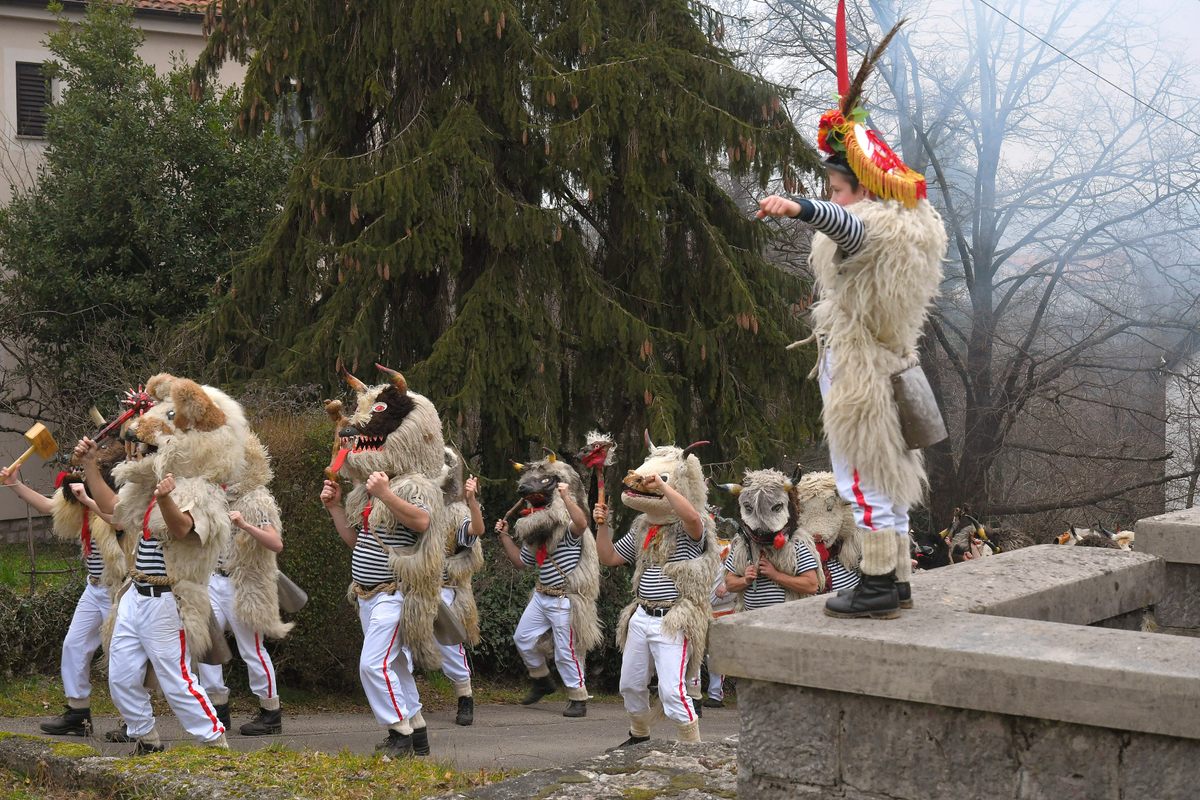The freshness of spring is already in the air by February in the Croatian hilltop village of Viskovo. A riotous noise approaches: a cavalcade of bell-ringing, music, and screaming. In a magical-seeming ritual, an army of men in grotesque animal masks dance, draped in sheepskins, armed with axes and clubs.
They huddle into a concentric circle and shake their rumps, clattering hundreds of cowbells in unison. They’re orchestrated by a flamboyant commander (the komandante) in an all-white uniform and golden epaulets. A devil clad in black dances on a rooftop, while a man dressed as a bear terrorizes locals, soundtracked by the happy chaos of a brass band.
If it sounds like a scene from a surrealist horror film borrowed from the minds of Stanley Kubrick or Alejandro Jodorowsky, keep in mind this strange, Viking-like army is harmless. Really, it has more in common with Where the Wild Things Are. This is the annual Habuje Zvončari (bell ringers) procession, a pre-Christian tradition that’s endured for hundreds of years in the Kastav region of Croatia. And for many towns, it’s time to let the wild rumpus begin.

The pack roams from village to village for days, terrorizing townsfolk with noise and hijinks till the bystanders offer up donations of food and wine. Afterwards, the Zvonarciy rampage onto the next town to do it all over again. The bell-ringing continues until Ash Wednesday, when they burn a symbolic figure called Pust, setting alight all the metaphorical misgivings of the past year and giving rise to fresh beginnings.
In Pagan times, this performance served a ritualistic purpose. It was supposed to awaken the fertility gods during the dour winter months, scare away evil spirits, and protect livestock from any curses levied against them.

However, the president of the Habuje bell ringers, Damir Host, has an alternative theory about the Zvončari’s provenance. During an invasion by the Ottomans in the Middle Ages, the Turks camped nearby in a karst field known as Grobničko polje. Terrified locals didn’t know how to respond, so blanketed by night, they wrapped themselves in sheepskins and the bells they used for tracking livestock and walked triumphantly towards the field of invaders. When the Turks saw “these people in crazy attire, they got scared and fled—that’s what the legend says,” Host explains.
These days, the riotous dancing and yelling is a commemoration of ancient customs. The Shrovetide celebrations culminate in Rijeka’s city carnival, one of the largest in Europe, which showcases the various bell ringers from different regions as part of its colorful parade.
The oversized, almost-cartoonish costumes are what bring the event to life. Giant, menacing animal heads stare at the crowd with lifeless black eyes, but not without a strange gentleness to them. They could almost be loveable.

“Facial masks cause a change in the behavior of their wearers. The magical empty faces are only seemingly mindless—they bear layers of ancient meanings and purposes,” writes the Croatian anthropologist Ivan Lozica in his essay about Croatian carnival traditions.
“Each mask represents an animal. The masks aren’t realistic; they have elements of a wolf, a fox, or a wild boar. Everyone adds their element,” adds Host. The original masks weren’t dissimilar in their frightening aesthetic. “It was once just plain leather with two holes for eyes, a corn cob for a nose, and a hole for the mouth.” The eerier, the better, has always been the central guiding principle behind their design.
Like with many ancient Pagan practices, the Zvončari have weathered attempted erasure by the spread of Christianity and disapproving church leaders. After World War I, Kastavština was divided in two: the west under Italian rule, and the east forged part of the Kingdom of Yugoslavia. The Italians effectively banned mask-wearing. “They didn’t allow the Zvončari to cover their faces, so these bell ringers made hats with flowers and asparagus; their faces were uncovered,” says Host. After World War II, they were on “shaky ground, because the Yugoslavian system after 1945 didn’t approve. There were several problematic years, but the tradition stayed alive.”
Thanks to locals like Host, this tradition has endured wars, invasions, and different regimes. It also represents a rite of passage, where boys grow into men. “Zvončari are not just carnival participants; it’s a way of life,” says Host.

The Zvončari treat the ritual with almost militaristic seriousness. Despite knocking back rakia (potent Croatian brandy) at 8 a.m., they volunteer to carry out these heavyweight duties, walking over 12 miles (20 kilometers) a day for six days, festooned with animal hides and heavy brass bells. “The whole Zvončari equipment weighs about 20 kilograms [44 pounds], and the bells have a volume of 10 liters [two and half gallons],” says Host.
The karnival embraces a fiendish, anarchic spirit with an “anything-goes” atmosphere. But it also represents a time of renewal. It’s a way to let loose after the long, stifling winter. People can let out their demons, indulge, and go wild without the usual moral judgments. All is forgiven at the carnival.
But just as the case is for Max from Where the Wild Things Are, there comes a moment when “it’s time to return, replenished to the comforts of home.” After giving into the excesses of the carnival—wild dancing, pyre burning, eating, drinking, screaming, feet-stamping—the darker days of winter are expelled. Everyone returns to the comforts of their homes, happy, replenished, and ready for the promise of new beginnings.






